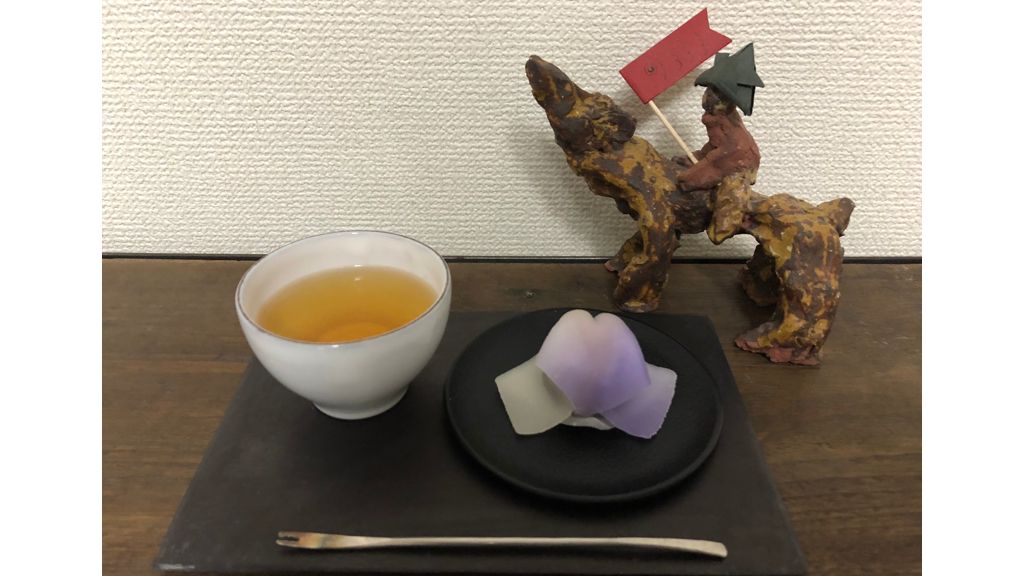May 2018 – Shimanto Hōjicha from Kōchi
This month we selected a Shimanto Hōjicha (四万十ほうじ茶) in the village of Shimanto (四万十) from the prefecture of Kōchi (高知), on the island of Shikoku (四国).
Shimanto Hōjicha
This is a Hōjicha (ほうじ茶) produced on the bank of Shimanto River (四万十). The production area is wrapped in fog in the morning and there is a remarkably sharp drop in temperature between day and night. This makes this place perfectly suitable for the production of Japanese tea.
Most of the tea trees are planted on slopes, therefore we need to harvest the leaves by hand. Hōjicha produced like this has no dead leaves, and a delicate taste. Since this Hōjicha has no complexity in the taste, and very little caffeine, we can drink it anytime, even before bedtime.
I tasted it with a Japanese style cake called “Karakoromo (唐衣)”. Originally it meant a Chinese (唐) clothes (衣), then the meaning evolved to that of a vest for women. As the Japanese water iris, Kakitsubata (杜若), reminds us of this jacket, it became a synonym of Karakoromo.
This is especially true in Japanese patisserie, due to the following ancient poem: 「からころも きつつなれにし つましあれば はるばるきぬる たびをしぞおもふ (Karakoromo Kitsutsunarenishi Tsumashiareba Harubarukinuru Tabioshizōmofu). Here is a translation: “Just as a karakoromo comfortably fits my body after wearing it a long time, I comfortably fit my wife. I however came all the way to the East, leaving her behind in Kyoto. Alas, it is heartrending to travel so far.” If we combine the first syllable of each verse together, we can make the word “Ka-Ki-Tsu-Ba(Ha)-Ta”. It's a word-play. We can see these water iris in this season, it is one of the symbols of May.

"Come and see" or "Come here, carps" !
May 5th is the children’s day -especially boys- festival in Japan, while March 3rd is reserved for girls. In the families with boys, we decorate Gogatsu Nigyo (五月人形), a doll of a samurai or a classical hero, like Kintaro (see the blogpost of March 2017 for this character) or Koinobori (鯉のぼり), a flag made of cotton fabrics in the shape of a carp that we fix up above the house, wishing a healthy growth to children.
The carp is a symbol of social success, because carp swim upstream, to the top. We used believe that carps become dragons once they reached the top of the river. That’s why we appreciate carps, even though we eat carps in some districts of Japan. There is the festival of Yottekoi Shimanto (よってこい四万十) on the bank of Shimanto river during this period. Many carps made of cotton fabrics float above the river. Yottekoi (よってこい) has 2 meanings: “Come and see” and “Come here, carps!”.
Brewing Shimanto Hōjicha
The amount of tealeaves should be adapted according to the desired taste: it should be around 2 to 3 tablespoons (5 grams) of Shimanto Hōjicha for 250ml (8.5oz) of spring water. The infusion should last 30 seconds to one minute in water above 95ºC (200ºF).
People of Shimanto usually drink Hōjicha boiled. Prepare 2 liters (half a gallon) of boiled water in a kettle, add a handful of tea leaves and let it boil on low heat for approximately 2 minutes. Turn off the heat and let it brew for an extra one minute. Remove the leaves by passing the tea in a strainer.
You can also prepare cold Hojicha and Hojicha Latte (see the blogposts of February 2017 and December 2017).
If you have questions about Japanese teas, please do not hesitate to contact us!
